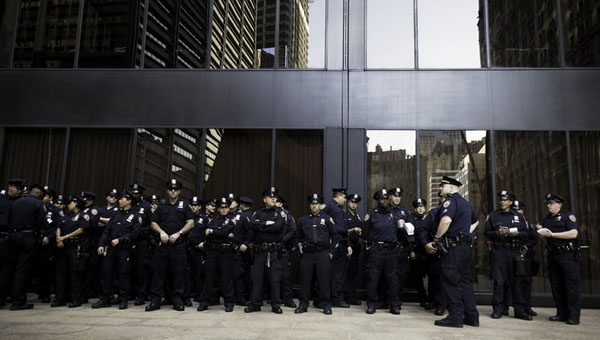By Yvonne Sam
Contributing Columnist
 On December 9, 1948, the Genocide Convention, Article 2, adopted by the General Assembly of the United Nations, defined genocide thus: “any of the following acts committed with intent to destroy, in whole or in part, a national, ethnical, racial or religious group, as such: killing members of the group; causing serious bodily or mental harm to members of the group. www.un.org/en/genocideprevention/documents/atrocity-crimes
On December 9, 1948, the Genocide Convention, Article 2, adopted by the General Assembly of the United Nations, defined genocide thus: “any of the following acts committed with intent to destroy, in whole or in part, a national, ethnical, racial or religious group, as such: killing members of the group; causing serious bodily or mental harm to members of the group. www.un.org/en/genocideprevention/documents/atrocity-crimes
The term consists of the Greek prefix genos, meaning race or tribe, and the latin suffix cide meaning killing. The author of the term — Polish lawyer, Raphael Lemkin — developed the term partly in response to the Nazi policies of systematic murder of Jewish people during the Holocaust, but also in response to previous instances in history of targeted actions aimed at the destruction of particular groups of people. www.un.org/en/genocideprevention/genocide.shtml
Clinging firmly to this definition, I am maintaining that Blacks in America are victims of genocide, by virtue of the consistent, conscious and unified actions of the police.
As the Latin expression states, Quis custodiet ipsos custodes? a phrase from the Roman poet, Juvenal, literally translated as “Who will guard the guards themselves?” It is also sometimes rendered as “Who watches the watchmen.
The police question is a truly complex one. However, the excessive use of force is a reality, to the point where it has become a public safety and health crisis.
The enigma remains—are there just some rotten apples, rotten bushels in a truly rotten tree—a racist and corrupt system of policing, connected to a broader dysfunctional criminal justice system and an unequal social structure?
Law enforcement is basically a hotbed of racism, for despite unprecedented video evidence, accountability remains rare.
America bears daily witness to what can safely be termed an epidemic of police abuse—the shooting of unarmed Black people. Police abuse has a long history, and appears to defy any, and all, attempts at eradication. The truth we can no longer hide, it’s plain and simple genocide.
Given the horrifying history of racism in the United States, this was never a far-fetched thesis, as is evidenced by the foregoing acts, a small representation of the horrendous injustices, perpetrated by whites and law officers, against Blacks, between 1945 and 1951.
August 21, 1945: Ervin Jones was fatally wounded in his home in Portland, Oregon, when three police officers came to the house to search the premises. They had no warrant and failed to identify themselves as officers. The Jones family believed them to be burglars. Jones defended his home against their entry. One of the officers went to the rear of the house, entered, and shot Jones in the back with a sawed-off shot gun, killing him. The coroner’s jury exonerated the police and a grand jury subsequently refused to indict them. depts.washington.edu/moves/CRC_genocide.shtml
September 9, 1945: Moses Green, veteran of World War I, was shot to death by two Aiken County law officers near Elenton, South Carolina. The officers were deputy sheriffs who were identified. Green was returning from town in his truck and as he stepped out into his own yard he was shot, without warning. www.crmvet.org/info/genocide5_evidence-a.pdf
May 18, 1946: William Arthur was killed in Baltimore, Maryland, while allegedly resisting arrest by police officers. The following day, May 19, Wilbur Bundley was killed by an officer. Nine witnesses stated that he was shot in the back while running. A few days later, Isaac Jackson was shot and killed by a policeman. A number of organizations began a protest against consistent police brutality in Baltimore
June 7, 1947: Willie G. Andrews was shot and killed in Warrenton, North Carolina, by Police Chief, Will Carter, of Norlina, who claimed Andrews tried to seize his gun.
October 12, 1947: Beverly Lee, 13-year-old youth, was shot by policeman, Louis Begin, of Detroit, Michigan. Mrs. Francis Vonbatten, of 1839 Pine Street, testified that she saw the dead youth and another walking down the street and saw the squad car approach. She heard “Stop, you little so-and-so” and then a shot. The officer was subsequently cleared by Coroner, Lloyd K. Babcock.
February 27, 1948: Roy Cyril Brooks, member of Local 309, Food, Tobacco and Agricultural Workers, was shot down in cold blood in the crowded, bright, sunlit public square of Gretna, Louisiana. Brooks’ murderer was a uniformed policeman, Alvin Bladsacker. A Committee for Justice in the Brooks case protested and under pressure; Bladsacker was indicted for manslaughter. He was later released and put back on his job.
Week of March 21, 1948: Samuel Bacon, 55, was shot to death in a Fayette, Mississippi jail by Town Marshal, S. D. Coleman. Bacon, an employee of the Firestone Rubber Co. of Akron, Ohio, had been arrested and taken from a bus, while on his way to Natchez, Mississippi to visit relatives.
March 27, 1948: Ike Madden, 27, was slain by Birmingham, Alabama police, who claimed he was “resisting arrest”.
March 29, 1948: John Johnson, 50, was slain by Birmingham, Alabama police, who claimed he was “resisting arrest”.
August 21, 1948: Herman Burns, a Black war veteran, was beaten to death by Los Angeles police, outside the La Veda Ballroom. At the same time, his brothers, Julius and John, were attacked by several police. Mrs. Virginia Burns, the widow of the slain man, sued the city for $200,000, naming Mayor Bowron, Police Chief Clement Horrall, and Asst. Chief Joseph Reed as being derelict in their duty for failing to suspend or discharge the killer cops.
October 16, 1948: Danny Bryant, 37, of Covington, Louisiana, was shot to death by policeman, Kinsie Jenkins, after Bryant refused to remove his hat in the presence of whites.
Week of January 2, 1949: Herman Glasper, 30, was shot and killed in Bryan County, Georgia, by State Trooper Corporal, Dee E. Watson. Glasper had been arrested on suspicion of being a hog thief. Sheriff E. W. Miles claimed that the shooting was an accident that Watson shot when he stumbled over some bushes.
January 16, 1949: Charles Phifer was shot in the back and killed in the home of his stepmother, Mrs. Anne Phifer, of the Bronx, New York. Patrolman, Eugene Stasiuk, had been called to settle an argument and claimed Phifer attacked him. He failed to explain how he shot him in the back.
May 8, 1950: Thurmond Towns, 19-year-old garment worker of the Bronx, New York, was killed in New York City, by police of the 32nd Precinct. Towns was shot in the St. Nicholas Park, after police claimed he ran when they sought to question him about a purse snatched from a woman passerby. Towns, however, was found to have a large sum of money in the bank, and was known as a model citizen and unionist.
October 7, 1950: Morris Scott was slain in Linden, Alabama by William R. Welch and George Baker. Welch admitted firing the shotgun blast that killed Scott in his home. County Sheriff, T. Wilmer Shields, declined to disclose a motive for the killing.
December 1, 1950: Sam Jones, 35, of San Pedro, California, a construction worker and member of AFL Laborers’ Local 802, was beaten to death by Policemen, James R. Graham and Richard W. Clare
December 7, 1950: John Derrick, a veteran just discharged from Fort Dix, N. J., was shot down in Harlem, New York City, at 119th Street and Eighth Avenue, by Patrolmen, Louis Palumbo and Basil Minakotis, attached to the 28th Precinct. Derrick was slain with his hands in the air. The policemen were subsequently cleared by the New York County Grand Jury.
January 13, 1951: Andrew Johnson, 19, was killed by Chicago police in the Central Station. The young worker was arrested and charged with the murder of Coleman Hairston, a barber, during a holdup, but Sonny Porter, a porter in the shop, said Johnson did not look like the holdup man. Porter’s testimony was barred by Coroner A. L. Brodie. depts.washington.edu/moves/CRC_genocide.shtml
October 12, 2019: Atatiana Jefferson, 28, was fatally shot by a Fort Worth police officer, Aaron Dean, when the officer responded to reports of an open front door. The police officers had been dispatched around 2.30 am on Saturday, to the home of Jefferson in response to a non-emergency call from a neighbor, who noticed the doors ajar and requested a welfare check. Body camera footage, released by police, showed the two officers peering into Jefferson’s house through a pair of screen doors, then walking stealthily into the backyard. Dean shined a flashlight into a closed window and, without identifying himself as police, shouted, “Put your hands up! Show me your hands!” A split-second later, he opened fire, killing Jefferson. www.nbcnews.com/news/us-news/texas-police-officer-shoots-woman-death-inside-her-home-n1065451
The racist behavior, displayed by the police, is part of the deep legacy of racism in the United States, which now finds extreme expressions in law enforcement (a few cops have even belonged to the Klan). It has been honed through years of aggressive policing and hypercriminalization of the Black community. Census data shows that about 20 percent of Fort Worth’s more than 830,000 residents identify as Black.
There has been nine officer-involved shootings this year, with six of them turning fatal. All but two of the people involved in the shootings were either Black or Latino. In 2018, there were 10 police-involved shootings, half of which involved people of color and four that were fatal. Jefferson’s shooting, is the seventh local police shooting involving a civilian since June 1. www.nbcnews.com/news/us-news/it-triggers
The frequency of these killings has been cited as symptomatic of deeply-rooted racism, and is, in any case, perceived as such by most Black Americans. In December 1951 the Civil Rights Congress (affiliated with the Communist Party) engaged in a campaign to hold the United States accountable for genocide against African Americans.
We Charge Genocide: The Historic Petition to the United Nations for Relief from a Crime of The United States against the Negro People, a 78-page petition, was delivered to the General Assembly of the United Nations in Paris. The petition sought to demonstrate that the government of the United States was in violation of the U.N. Genocide Convention. The Civil Rights Congress offered as evidence in support of their claim 152 incidents of the killings of unarmed Black men and women by police and by lynch mobs between 1945 and 1951.
The Convention on the Prevention and Punishment of Genocide had been adopted in 1948 in the aftermath of the Holocaust. www.blackpast.org/african-american-history/civil-rights-congress-1946-1956/. In 1964, Malcolm X and his Organization of Afro-American Unity, citing the same lynchings and oppression described in the petition submitted by the Civil Rights Congress, began to prepare its own petition to the UN, asserting that the US government was engaging in genocide against Black people elibrary.law.psu.edu/cgi/viewcontent.cgi?article=1424&context=psilr
The injustices being inflicted upon Blacks in America, today, should be brought to the attention of the United Nations. No longer can the deadly acts be looked upon as civil rights issues, but rather as human rights violations.
Human rights are God-given rights. Let’s be fair the definition is clear. Color aside it’s plainly genocide. The petition is as relevant today as it was in its own time, over seven and a half decades ago. So to the United Nations we should go and clearly show the human rights violations perpetrated by America against her Black citizens.
Yvonne Sam, a retired Head Nurse and Secondary School Teacher, is Vice-president of the Guyana Cultural Association of Montreal. A regular columnist for over two decades with the Montreal Community Contact, her insightful and incursive articles on topics ranging from politics, human rights and immigration, to education and parenting have also appeared in the Huffington Post, Montreal Gazette, XPressbogg and Guyanese OnLine. She is also the recipient of the Governor General of Canada Caring Canadian Citizen Award.
 Pride News Canada's Leader In African Canadian & Caribbean News, Views & Lifestyle
Pride News Canada's Leader In African Canadian & Caribbean News, Views & Lifestyle





